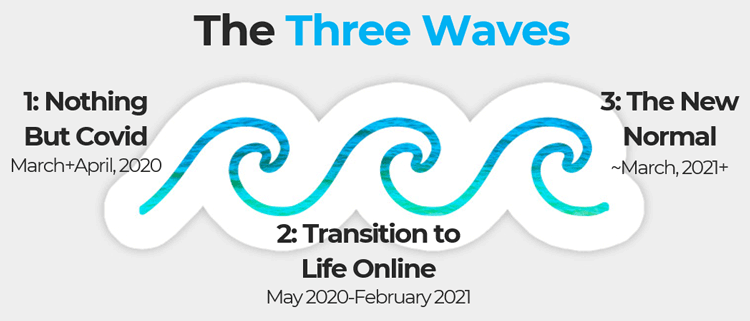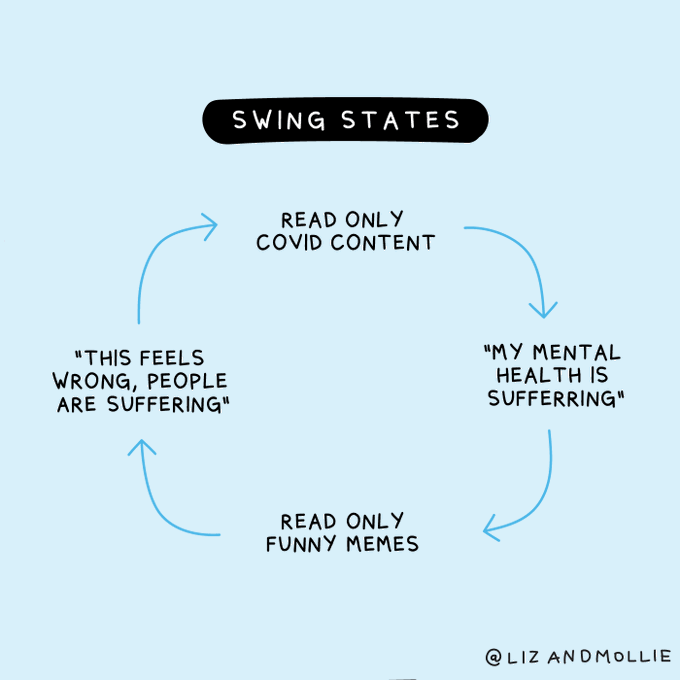When folks ask me about how best to do marketing right now, my answer is consistently turning into the same three words: Read the room.
Imagine you’ve walked into a religious space. This room is sacred to the people inside it. When you speak, whatever you say will be viewed through the context of where you are. That’s exactly what Covid-19’s done to our planet.
The world—the whole world—is experiencing this crisis all together. When you send a tweet, write an email, publish a blog post, run a webinar, broadcast or amplify anything right now, you’re sending that message within the context of the Coronavirus outbreak. I’d estimate we have (at minimum) another month where nothing in our lives exists without the filter of the viral crisis and the pains and restrictions it inflicts.

The signs are everywhere. An overwhelming majority of the traditional participants in April Fool’s Day have wisely and collectively decided not to celebrate this year. Every major online platform has taken immense, unprecedented steps to amplify the dangers of the Coronavirus, dampen false information, fact-check like never before, and create resources to help. Brands big and small are doing likewise. Celebrity culture has shifted almost entirely to messaging about the need to stay home. The words “unprecedented” and “crisis” finally mean something again. If we’re very lucky, every disaster for the next century will be compared against this one we’re living through.
That’s “The Room.”

Via The New Yorker
We don’t need marketing, content, advertising, or messaging of any kind that’s ignorant of or unsympathetic to this filter. When that stuff exists, it’s (rightfully) getting ignored, or worse, reflecting badly on its creators.

Via Liz And Mollie
I get it. I *want* to have some sense of normalcy, some space away from the drumbeat of increasing death, increasing length of quarantine, increasing risk to our global and national economic health. Damn, I really want it. And, sometimes, in personal ways, I get that escapism. I hop on a phone call with friends, or watch a dumb TV show, or play video games, or scroll through photos of my friends’ kids on Instagram.
But what I can’t, what *we* can’t reasonably expect is that our marketing is being received in the same context as escapism-centric content. So, instead, we have to be mindful. We have to read the room. And we have to respond, accordingly.
How to Read this Room
Great marketers deeply understand three things:
1) Their audience
2) Their company’s positioning—what painful problem they solve, why their solution is superior, and how it contrasts to others
3) How and where to message #2 to #1
That understanding comes from getting to know our market, our customers, their needs and problems, how they solve them today. The Covid crisis demands that we rapidly expand our empathy: we feel what our customers are feeling, what our customers’ sources of influence (press, media, journalists, social influencers, podcasters, YouTubers, talking heads on webinars & TV, et al) are feeling, what everyone is sharing in, and we respond accordingly.
Tactically, I recommend the following:
- Don’t stop marketing. As HBR points out, “On average, increases in marketing spending during a recession have boosted financial performance throughout the year following the recession.” What’s more, the marketing you do helps halt the dangerous decline in consumer & business spending that can create future crises.
- Do stop purely self-promotional marketing. No matter what you do, you need to find a way to relate it to the help you’re providing, the situation you’re improving. If you’re selling, sell the benefits that appeal to the moment or show how, when you sell, you’re giving back and making life better and easier for others.
- Don’t create only crisis-related content. It’s OK to write about, tweet about, talk about other things. When we socialize at funerals, we don’t exclusively talk about the deceased, but what we do talk about is informed and aware of the event’s context.
- Audit your marketing. You might have just launched some timely, empathetic content that nails the moment… but left up your unfortunate, tone-deaf “subscribe now!” popup. Double-check your entire marketing experience for messaging that doesn’t make sense right now.
- Don’t amplify harmful or dangerous activities. Want to speculate about how necessary the latest quarantine restrictions are or whether its worth sacrificing some lives so we can go out to bars & ball games? Keep it on your personal Facebook (or hell, just keep it off the Internet). It’s also not the right time to directly promote travel, in-person events, or gathering places of any kind. But, it’s a great time to indirectly build brand affinity and goodwill for even those businesses (some examples below).
- Do show how you’re helping. Opinions on this vary, and I know some folks prefer organizations and individuals keep their selfless acts truly selfless by keeping them quiet. I disagree, mostly because social sciences show us that the best way to encourage more altruism and helpful acts is to model them over and over.
Who is Reading the Room Right?
Let’s walk through some examples of reading the room in practice. All of these organizations are listening and responding in ways that resonated with me, and I suspect many others, too. They’re following the guidelines above, yes, but they’re also tapping into this rare moment like a person, a human being, not just a business.

Kettle & Fire’s Email Newsletter is promoting OTHER businesses. Yeah. I know. It’s awesome. They’re the opposite of self-serving, and by helping their audience (folks like myself, who subscribe to their email), they’re showing real empathy and selflessness in a time when it couldn’t be more needed or appreciated.

New Balance doesn’t have to make masks. And you might argue they don’t have to crow about it, either. But I’d argue that it is actually a great thing to show how you’re helping right now. That’s not merely because it helps your brand marketing in the future (though it probably does), but because it helps set an example for others. It helps set the tone of the room, so those who might not be stepping up can point their bosses/teams/clients to those who are.

Conversion Rate Experts, like a lot of companies, put together a Remote Work Guide recently. Several things makes theirs stand out, in particular, their recognition of the pain folks are going through right now, and messaging about why and how now is a uniquely hard time to be experiencing this challenge. They also put a lot of non-obvious, non-fluff advice in the piece, and intentionally positioned it that way to stand out from the crowd.

Burger King France put together this sweet (savory?) campaign to help folks make their own Whopper at home. I don’t even like Whoppers that much, but this made my mouth water for one… And it’s doing it in a way that doesn’t benefit their bottom line (to the best of my knowledge, Burger King has no direct financial relationship with the brands in the ad). It’s a subtle poke at themselves (yes, you can make our sandwiches at home) that simultaneously builds up future demand.

SEER Interactive is willing to be more directly promotional, but in a way that feels just right because it truly helps people. Their Marketing in a Recession: Budget Cuts guide is stellar. It’s showing off exactly how they help their clients through budget cut demands, in ways that reduce spend without cutting too deeply or dangerously into revenue generation.

Humble Bundle is drawing immense praise all over the web with their Conquer Covid-19 bundle of games. The package benefits organizations like Direct Relief and Partners in Health, and it leverages an industry that’s overrun with demand (video games) to help those less fortunate and serve those who need affordable game options right now.

Alaska Airlines changed their website’s entire positioning last month, focusing on health, safety, getting people home safely, and how to make changes to your travel plans easily without charge. I’ve liked flying them for years, but I gotta say my personal customer service experiences with them in late February/early March have made me a guaranteed customer for life.

GoWFH picked precisely the right moment to launch. There are plenty of job boards that have offered remote working possibilities and listings for a long time. There’s a few excellent direct competitors (like the great folks at Remoters). But “new” is a powerful marketing tactic, and “new” + “needed right now” + “exactly where the conversation’s going” has historically been one of the best ways to launch. They’re especially wise for offering free job listings at a time when budgets are tight.
Should We Launch Our New Product, Campaign, or Content? If Not Now, When?
This is a tough question. For some, there’s no choice. Maybe you’ve been working toward a Spring 2020 launch and your bank account simply can’t survive an extra month without revenue, even if it’s small. To those folks, I’d just say do your best reading the room, launching with an empathetic ear, and preparing for a second marketing push (new features, maybe a big upgrade) in 30-60 days when, fingers crossed, the environment is more welcoming.
But for everyone else, my advice is this: decide whether you’re either:
1) Highly relevant to the ongoing crisis and able to position your launch to be helpful to those impacted
2) Less relevant and able to wait
If you’re in group #1, position using the tactics above, make sure you’re reading the room, but go for it. New and helpful right now is a powerful combination and there’s plenty of ways to be the help someone needs in this moment.
But if you’re in group #2, I’d wait. Maybe only 2-3 weeks, as it does feel that, at least in some communities, the conversation is starting to move on. But, in others, it might be a month or two (or longer if you’re dependent on activities entirely curtailed by quarantine). That’s not just because it’s the wrong time to be blasting an irrelevant message. It’s because you’ll be competing for attention with content, messages, and launches that are more relevant, more worthy-of-everyone’s time and attention, more appropriate to this room we’re all in.
It’s self-serving AND in service of others. By waiting for the right moment to broadcast your campaign (be it about a product, a piece of content, an event, whatever), you’re giving yourself a better shot of future success. You’re also giving space and air to those who need it now. And you’re giving a jolt to a future economy that’s going to need your help getting on the road to recovery.
Stay safe. Stay home. Wash your hands. Together, we’ll get through this.